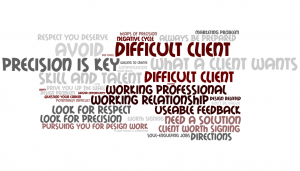 We’ve all been there: You’re stuck in a design related working relationship with a difficult client. This sort of customer is likely to drive you up the wall before they actually give you any sort of usable feedback. It’s a negative cycle that could make you question your career, as well as your sanity, and the downward spiral continues until you finally chop things off at the head. But before you enter this fun-land of wasted opportunity, you should know there are ways to recognize a potentially difficult client.
We’ve all been there: You’re stuck in a design related working relationship with a difficult client. This sort of customer is likely to drive you up the wall before they actually give you any sort of usable feedback. It’s a negative cycle that could make you question your career, as well as your sanity, and the downward spiral continues until you finally chop things off at the head. But before you enter this fun-land of wasted opportunity, you should know there are ways to recognize a potentially difficult client.
Typically you’ll experience a few red flags right off the bat, and if you can catch them early enough, you might be able to scrap the project before the contract gets off the ground. Take each of the points below with a grain of salt, but if you use them, you may just find yourself avoiding some terrible, soul-engulfing jobs!
- Look for Respect: First and foremost, a client worth signing will always—and we mean always—treat you with the respect you deserve. If they’re pursuing you for design work, this means they have some kind of design or marketing problem, and they need a solution. Any businessman worth his salt will recognize you as a working professional that can help them achieve their five year plan. If you encounter a client that treats you like dirt, or utters the phrase “My thirteen year-old son could do this!†you should treat the encounter as a tremendous red flag. What you do takes skill and talent, and dealing with someone that doesn’t respect this can seriously wreck your day.
- Precision is Key: Secondly, look for precision in what a client wants, as well as what they give you for directions. Ideally, a client who can tell you without hesitation the kinds of materials they’re looking for, as well as how much they’re willing to put up, is worth signing. If a client is vague about compensation, or doesn’t seem interested in what you’re willing to create, they’re likely to flake out at some point during the design process. This train goes two ways, though: Always be prepared with a full list of what does or does not work for you, as well as exactly that which you expect from the customer. Don’t be vague, either, and if you both meet with heaps of precision in the middle, a good project is guaranteed.


![What Makes Photographers’ Logo Memorable? [Survey]](https://dc-prod-blog.sfo2.digitaloceanspaces.com/uploads/2015/02/camera_lens_bokeh.jpg)
